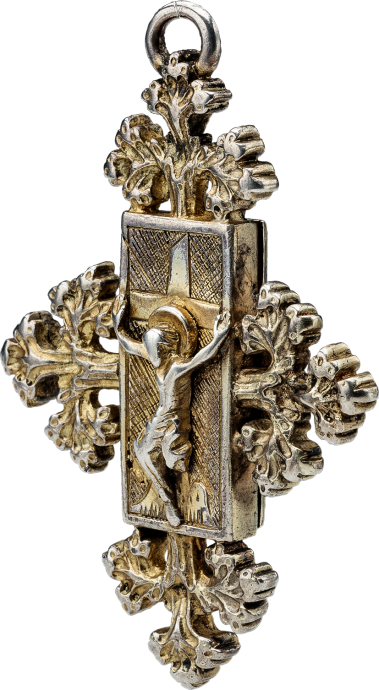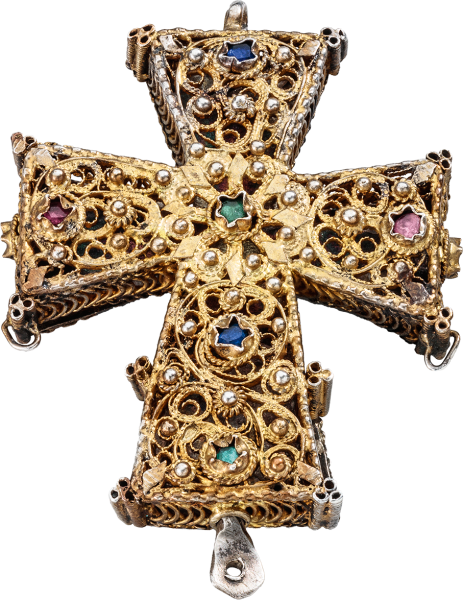


Reliquary Pendant with Christ on the Cross
, c. 1480–1500


Reliquary Pendant with Christ on the Cross
Description
A mixture of forms gives this pendant a rare expressiveness. At its core is a hinged rectangular box that likely once contained a relic fragment (the interior is gilded to match the shining exterior).
A tiny sculpture of the crucified Christ attached to the front surface of the box occupies the center of a minimalist composition representing the Crucifixion on the mount of Golgotha. As it typically does in Gothic and German renderings, the figure of Christ slumps down, hanging from painfully stretched arms. The tiny body, however, is elegant in its twisting angular collapse. It surely received repeated, attentive devotion from pendant’s owner and the surface is extensively rubbed. The face is obliterated, and only a few details of strained muscles of the left arm and ribcage are still visible in what once must have been a detailed and sensitive rendering of Christ’s body.
An engraved, flat depiction of the empty cross on the pendant’s back is less worn. The cross-hatched background recedes to let the surface of the shining cross emerge; the engraved drops of blood reiterate the story of Christ’s suffering and death (and repeat these same blood drops as on the front). Elaborate floriated arms extend the reach of the box’s cross imagery into elegant vegetal forms that not only echo the cross but also convey its fecund and life-giving qualities, a common symbol in images of the Crucifixion.
The German artist relied on forms in his artistic sphere for this exuberant curling and growing leaf form. The pendant’s leaf forms may reference the Eucharistic symbolism of the grape but the repeated Trinitarian three-leaf shape also emphasizes the sacred nature of the image. Through its artistic “flourish,” the ornament reinforces and literally extends the piece’s meaning.
The centerpiece of this gilded silver pendant is a flat rectangular box engraved on both sides with across on Golgotha Hill against a cross-hatched background. On the front panel is the figure of Christ on the Cross in high relief. The backplate is hinged and, when opened, reveals a compartment for relics (the hinge pin missing). The cross form is emphasized by four trefoil-shaped arms with Gothic foliage.
Comparisons and Literature:
This rare reliquary pendant is probably German. The design and details, such as the Gothic foliage, suggests that the goldsmith was inspired by the prints of Martin Schongauer (c. 1430/50-1491) and Master E.S. (c. 1450-1467); cf. exh. cat., Ornemanistes du XVe au XVIIe siècle 1987, nos. 8-9 and 10-13; Berliner 1925, vol. 1, figs. 5-10. This style of foliage can be found on various reliquaries and vessels of the period between 1480 and 1500, even on the print of an incense holder designed by Schongauer; see Fritz 1982, cat. no. 611, and further example of the period, cat. no. 760. The Christ figure with deeply angled legs is also reminiscent of depictions in Master E.S. and Schongauer prints; see Höfler 2007, figs. 30 and 32, 195.

